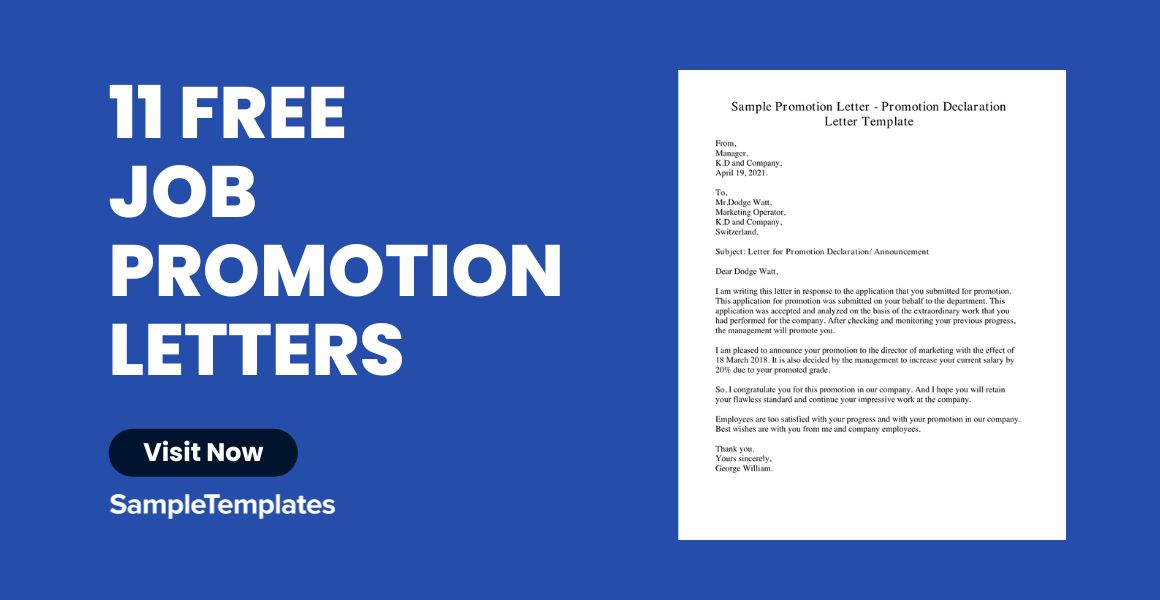Elevate your career trajectory with our Sample Job Promotion Letter Template, a pivotal resource for ambitious individuals. Designed to guide you in crafting an impactful Promotion Letter, this template emphasizes your professional achievements and readiness for advancement. It serves as an essential tool for anyone aiming to articulate their qualifications and aspirations in a persuasive manner. Perfect for those looking to make a significant leap in their career, this template aids in presenting your case effectively to decision-makers, setting the stage for your next successful career move.
1. Sample Job Promotion Letter
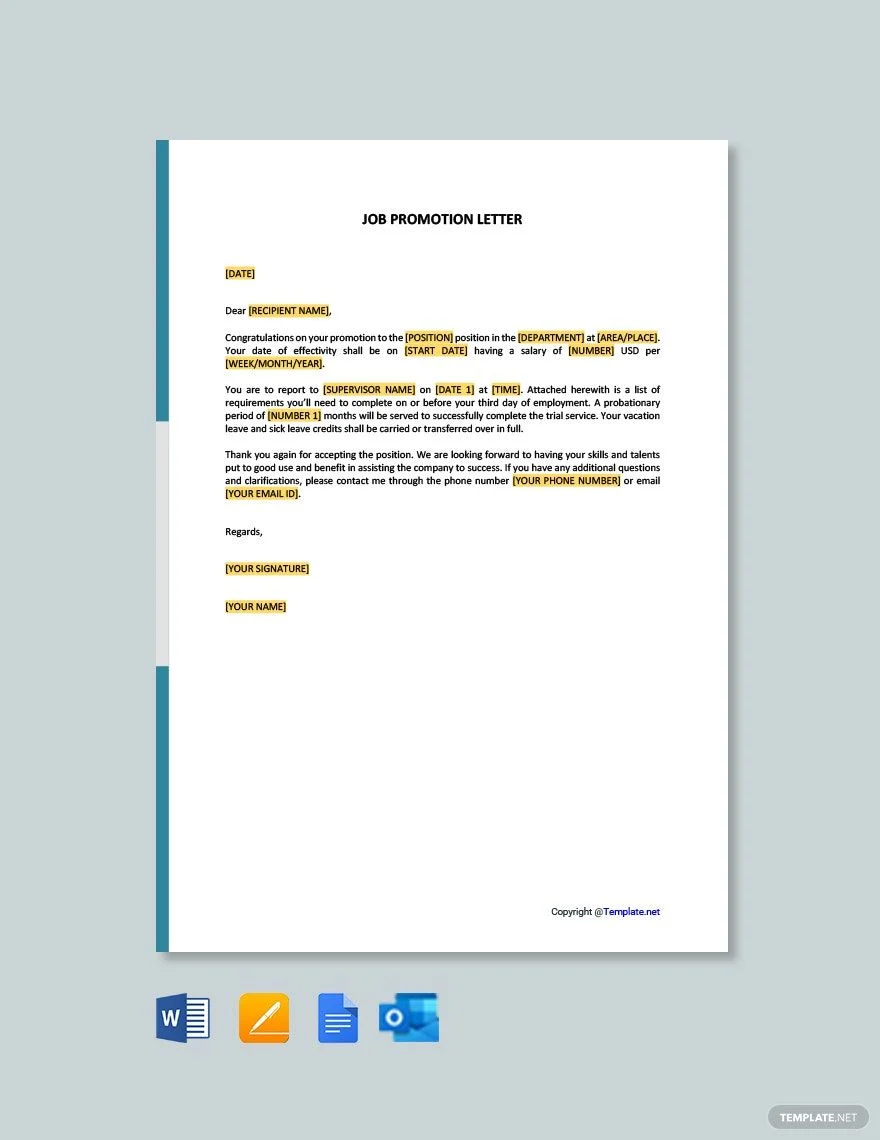
2. Job Promotion Offer Letter Template
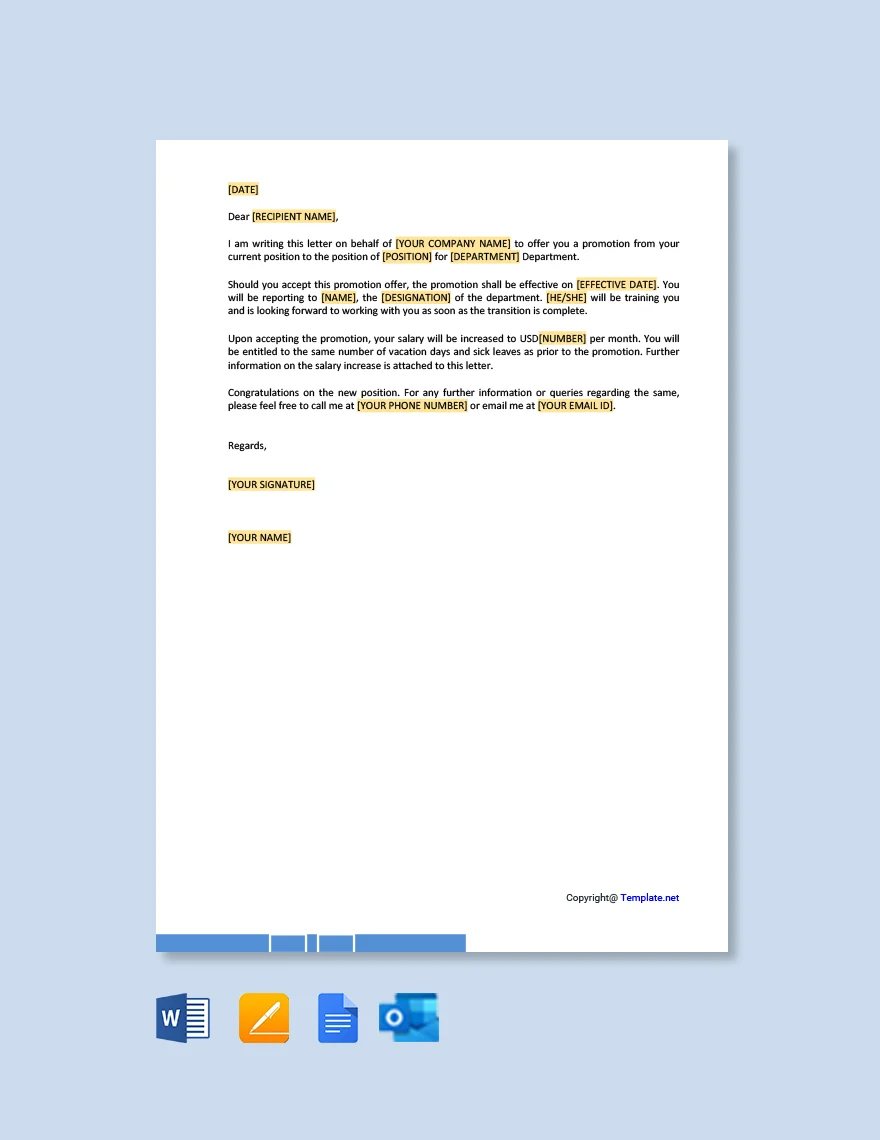
What Is a Promotion Letter?
A Promotion Letter is a formal document provided by an employer to an employee that officially announces the employee’s advancement to a new position within the organization. This letter serves as a formal acknowledgment of the employee’s growth and contributions to the company, signifying a new phase in their professional journey.
The key elements of a Promotion Letter include the official announcement of the promotion, the new title or position, any changes in responsibilities and duties, and often, details regarding any new salary or benefits associated with the upgraded role. It serves as an official record of the employee’s career progression and is a significant milestone in an individual’s professional life.
A Promotion Letter is not just a symbol of recognition and trust from the employer; it also motivates the employee to continue their hard work and dedication. It’s a testament to their skill, reliability, and potential for future growth within the company. This letter often reflects the employee’s past achievements and how they align with the new role’s expectations. It might also include the date from which the promotion becomes effective, providing a clear timeline for the transition.
For employers, issuing a Promotion Letter is a strategic move. It demonstrates the company’s commitment to nurturing and rewarding talent, which can boost overall morale and set a precedent for other employees. It shows the company’s investment in its employees’ growth and development, fostering a positive and productive work culture.
Furthermore, a Promotion Letter often outlines the expectations and goals associated with the new position. This clarity helps in ensuring that the employee understands their new role and responsibilities, aiding in a smoother transition. It also sets the stage for the employee’s future contributions and success in their new position, aligning their goals with those of the organization.
Overall, a Promotion Letter is a crucial document in the professional landscape. It not only marks a significant achievement for the employee but also strengthens the employer-employee relationship, promoting a culture of recognition and professional development within the organization.
3. Job Promotion Recommendation Letter Sample
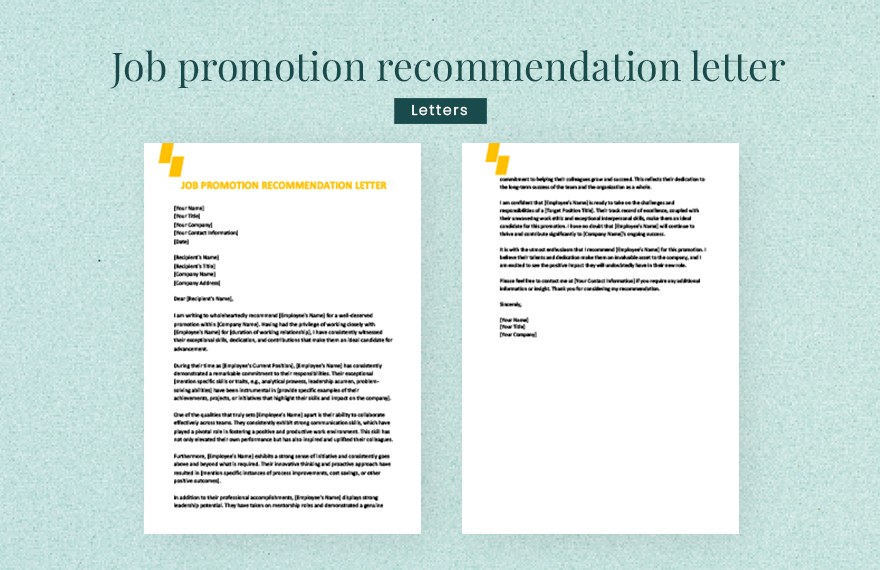
4. Sample Job Promotion Cove Letter Template

5. Job Promotion Application Letter Template
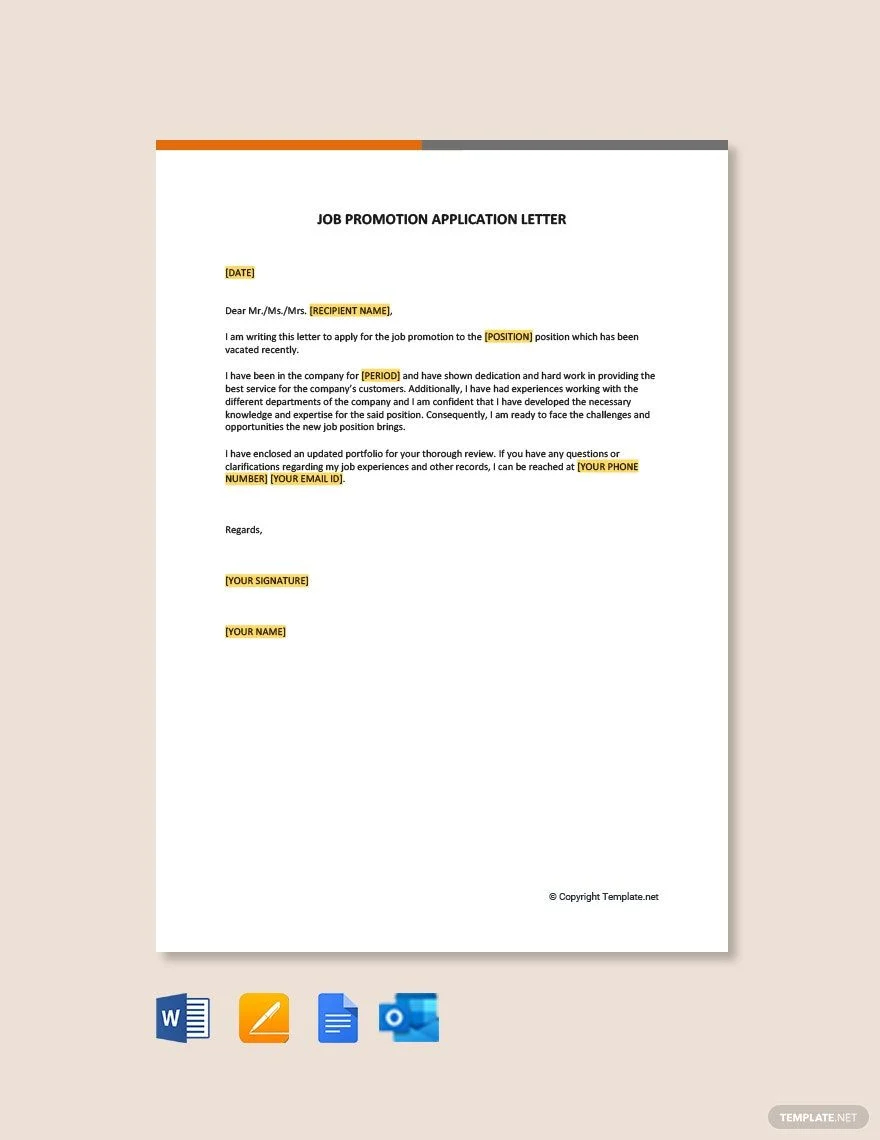
Contents of A Job Promotion Letter
A Job Promotion Letter is a fundamental document in the corporate world, marking a significant milestone in an employee’s career. This formal communication not only recognizes the employee’s contributions but also sets the foundation for their new role within the organization. Here are the key contents that typically comprise a Job Promotion Letter, expanded in detail:
Formal Introduction and Congratulations: The letter begins with a formal greeting and extends congratulations to the employee. This section sets a positive tone, acknowledging the employee’s hard work and achievements that led to the promotion.
Official Announcement of the Promotion: The letter explicitly states the purpose – the employee’s promotion. It includes the new job title and a brief description of the new role. This section is crucial as it officially communicates the change in the employee’s professional status.
Effective Date of the Promotion: The letter specifies the date from which the promotion will be effective. This is important for both administrative purposes and for the employee to understand when their new role and responsibilities begin.
Details of the New Position: A detailed description of the new role is provided, including the responsibilities and expectations. This section outlines the scope of the new position, giving the employee a clear understanding of what the job entails and the goals they are expected to achieve.
Salary and Compensation Package: The letter outlines any changes in salary, bonuses, or other compensation that accompany the promotion. This part is vital as it details the financial benefits that reflect the employee’s enhanced role and responsibilities.
Reporting Structure: It’s essential to mention any changes in the reporting structure. This includes information about who the employee will directly report to in their new position, and if applicable, who will be reporting to them.
Acknowledgment of Past Performance: The letter often acknowledges the employee’s past performance and contributions that led to the promotion. This recognition not only boosts morale but also reinforces the reasons behind the promotion decision.
Encouragement for Future Contributions: Employers use this opportunity to encourage continued dedication and contribution. This section conveys confidence in the employee’s abilities to excel in the new role and contribute to the company’s objectives.
Terms and Conditions: If there are any new terms and conditions associated with the new role, they are detailed in this section. This may include aspects like confidentiality agreements, non-compete clauses, or other legal and procedural formalities.
Invitation for Discussion or Queries: The letter often concludes by inviting the employee to discuss any queries or clarifications about the new role. This open communication policy helps in ensuring a smooth transition.
Closing and Signature: Finally, the letter closes with a formal closing statement and is signed by the relevant authority, typically a manager or HR representative.
A well-crafted Job Promotion Letter is not just a formal communication tool but also a significant motivator for the employee. It recognizes and rewards their hard work, setting the stage for their continued growth and success within the organization.
6. Job Promotion Information Letter Template
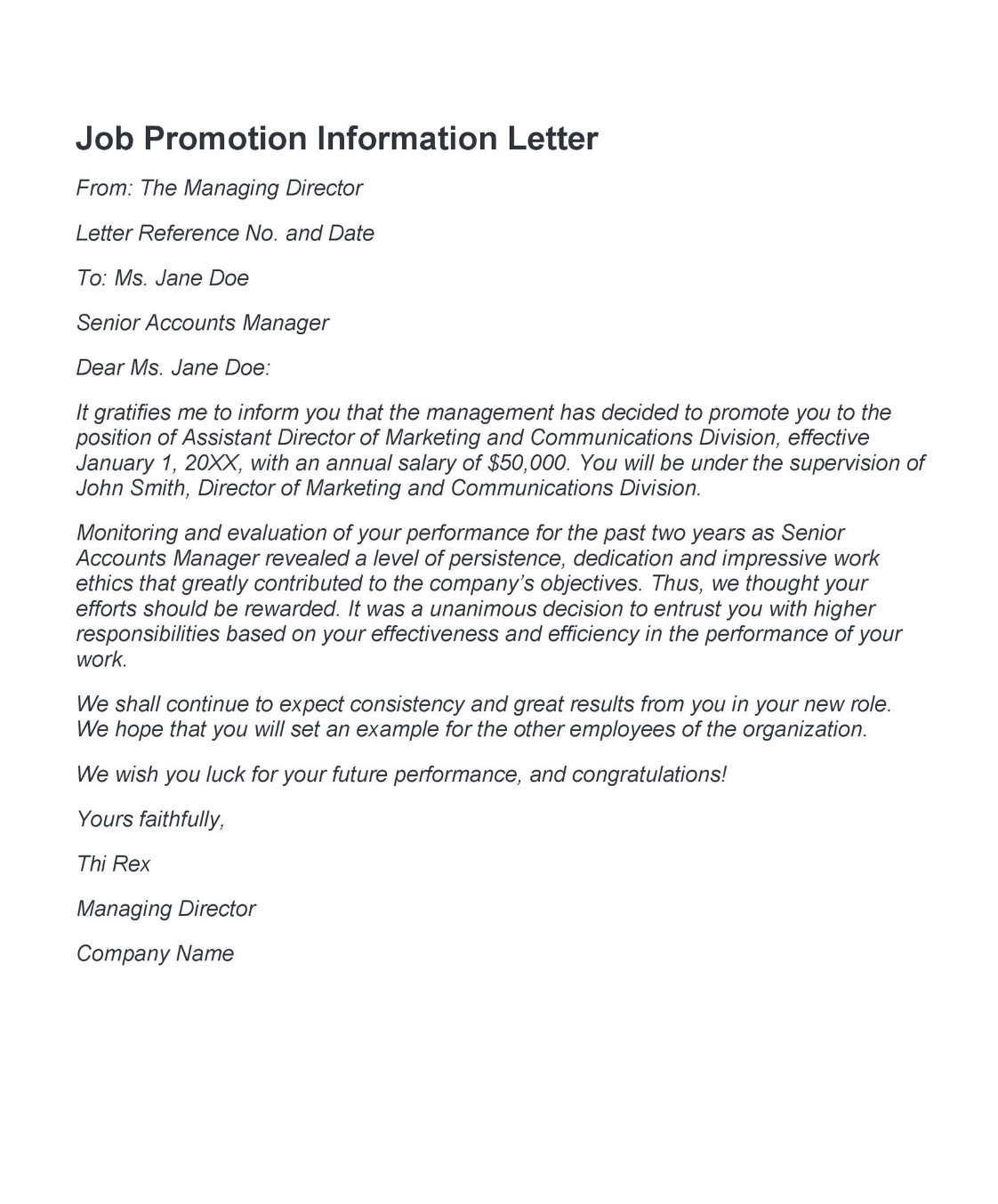
7. Job Promotion Announcement Letter Template
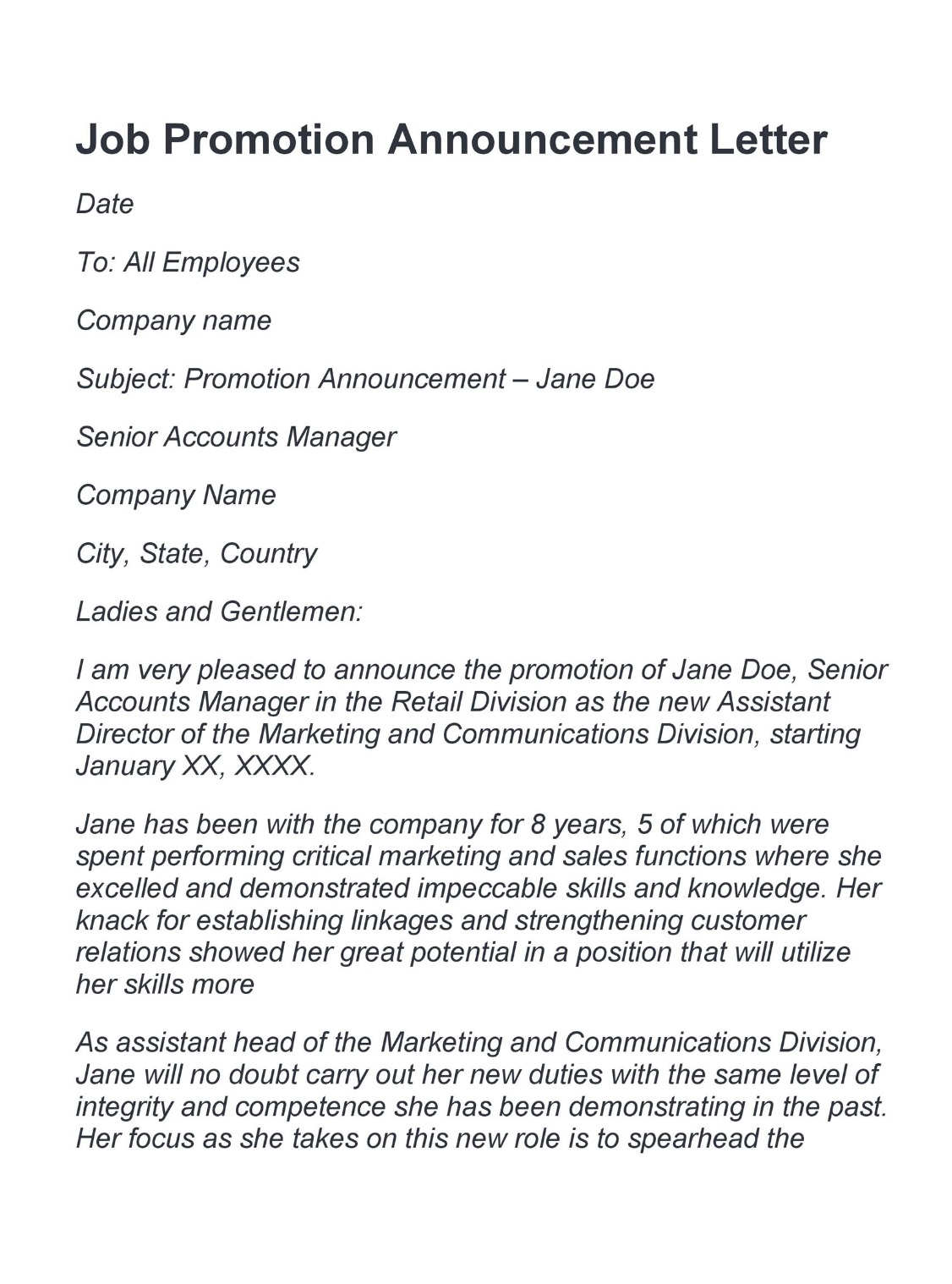
Tips for Writing a Job Promotion Letter
Crafting an effective Job Promotion Letter is crucial in conveying the right message to your employee. Here are some tips to ensure that your letter is both professional and impactful:
Understand the Purpose of the Letter
Before you begin writing, it’s essential to understand the purpose of a Job Promotion Letter. It’s not just a notification of a change in position, but also a recognition of hard work and a motivational tool for the future. This understanding will guide the tone and content of your letter.
Start with a Positive Tone
Begin the letter on a congratulatory note. Acknowledge the employee’s hard work, dedication, and contributions that have led to this promotion. A positive start sets an encouraging tone for the rest of the letter.
Be Clear and Concise
Clarity is key in a promotion letter. Clearly state the new position, including the title, and briefly describe the role. Avoid jargon or overly complex language. Your goal is to ensure the employee understands their new role and responsibilities.
Detail the New Responsibilities
Provide a detailed overview of the new responsibilities and expectations. This helps the employee understand what is expected of them in their new role, and prepares them for any changes in their daily tasks and overall responsibilities.
Discuss the New Salary and Benefits
If the promotion includes a change in salary or benefits, outline these clearly. Include specifics about pay increases, bonuses, and any additional benefits that come with the new position. Transparency in this area helps avoid any confusion or misunderstandings.
Outline the Effective Date
Specify the date when the promotion will take effect. This allows the employee to prepare for their new role and assists in a smooth transition.
Offer Support for the Transition
Promotions can come with challenges. Offer support to the employee during this transition period. Let them know that they can approach you or the HR department with any questions or concerns.
Encourage Future Growth
End the letter by encouraging the employee to continue their excellent work. Express your confidence in their ability to handle the new role and contribute significantly to the team and company.
Close Formally
Conclude the letter with a formal closing statement. It could be a simple thank you or a note of appreciation for their efforts.
Remember, a Job Promotion Letter is not just a formality; it’s a powerful tool for motivation and engagement. A well-written letter can boost an employee’s morale and set them up for success in their new role.
8. Job Promotion Letter Format
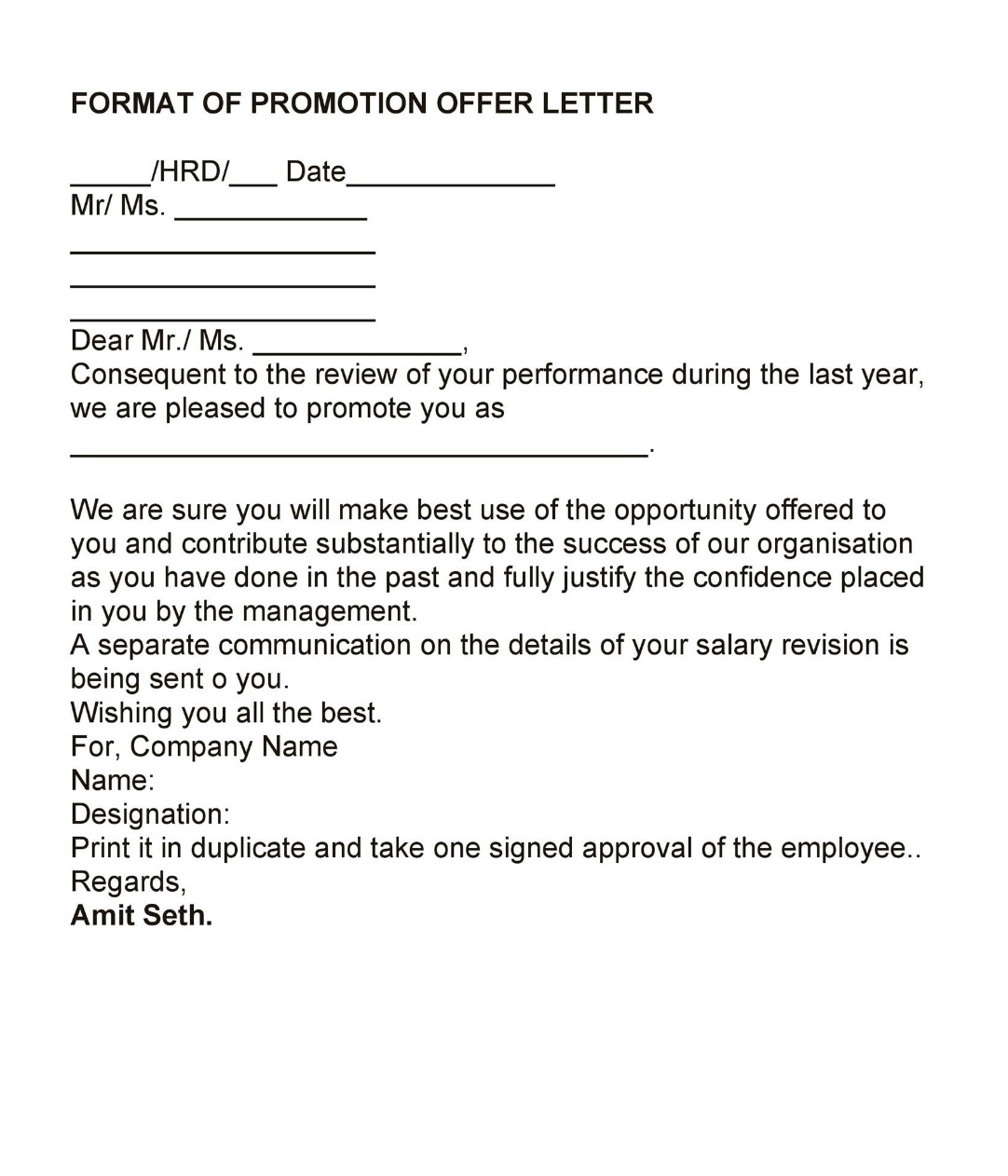
9. Sample Job Promotion Declaration Letter
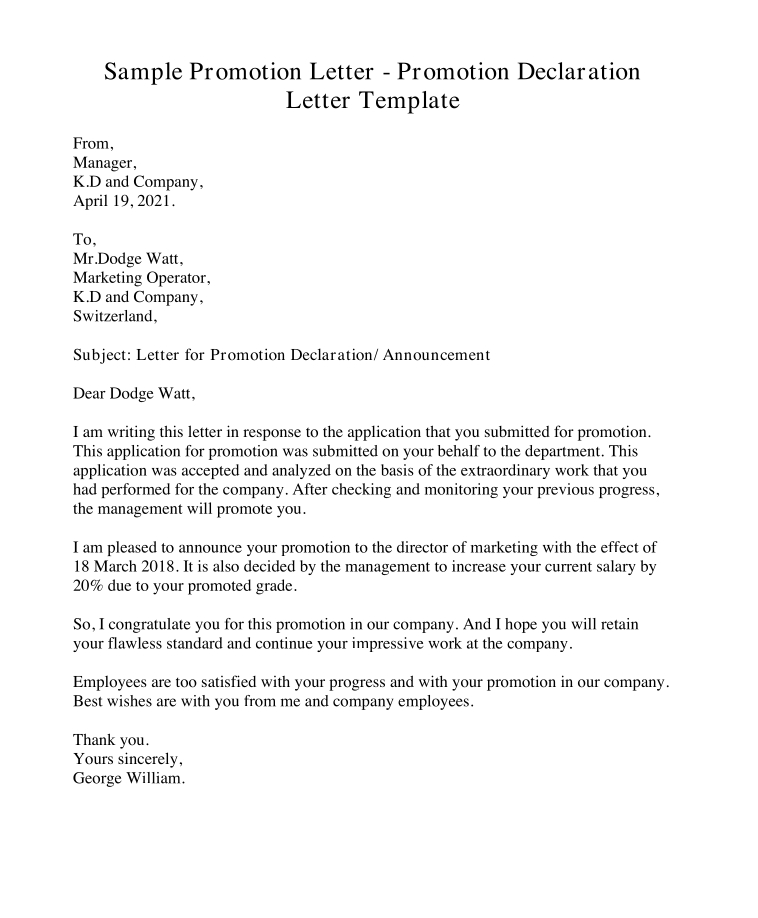
When to Send a Job Promotion Letter?
Sending a Job Promotion Letter at the right time is crucial for maintaining transparency and ensuring a smooth transition within your organization. Here’s a comprehensive guide on when to send a Job Promotion Letter, taking into account various aspects and scenarios:
After a Formal Decision is Made
A promotion letter should be sent only after a formal decision has been made by the management or the HR department. This decision is typically based on a variety of factors including performance evaluations, the employee’s skill set, and the needs of the organization.
Before Public Announcement
It is essential to send the promotion letter before making any public announcement within the company. This approach respects the privacy of the employee and allows them to be the first to know about their promotion. It also gives them time to consider and accept the offer before it becomes common knowledge.
During a Performance Review or Meeting
In many cases, promotions are discussed during performance reviews or personal meetings. If this is the case, the promotion letter can be handed over immediately following the discussion. This timing helps connect the promotion directly with the employee’s performance and contributions.
Before the New Role Begins
Ensure that the promotion letter is sent well before the employee is expected to start in their new role. This allows ample time for the employee to understand and prepare for their new responsibilities and for the company to manage any transitional arrangements.
During Organizational Changes
If the promotion is part of a larger organizational change, such as a departmental restructuring or expansion, the letter should be sent as soon as these changes are finalized. This helps the employee understand their role in the context of the larger organizational strategy.
When New Responsibilities are Assigned
In situations where an employee takes on new responsibilities before the official promotion, it is advisable to send the promotion letter concurrently with the assignment of these new duties. This aligns the official recognition with the change in responsibilities.
At the Start of a New Business Cycle
Sending the promotion letter at the beginning of a new fiscal year or business cycle can be strategic. It aligns the promotion with the company’s broader goals and initiatives and can serve as a motivational tool for the promoted employee and their colleagues.
Consider Legal and Policy Implications
Lastly, consider any legal and HR policy implications. Some organizations might have specific guidelines on when and how promotions should be communicated. It’s important to adhere to these guidelines to ensure consistency and fairness across the organization.
In conclusion, the timing of a Job Promotion Letter is a key factor that can significantly impact the employee’s perception of the promotion and their role in the organization. Thoughtful timing ensures that the promotion is received positively and that the transition to the new role is as smooth as possible.
10. Job Promotion Congratulation Letter Sample
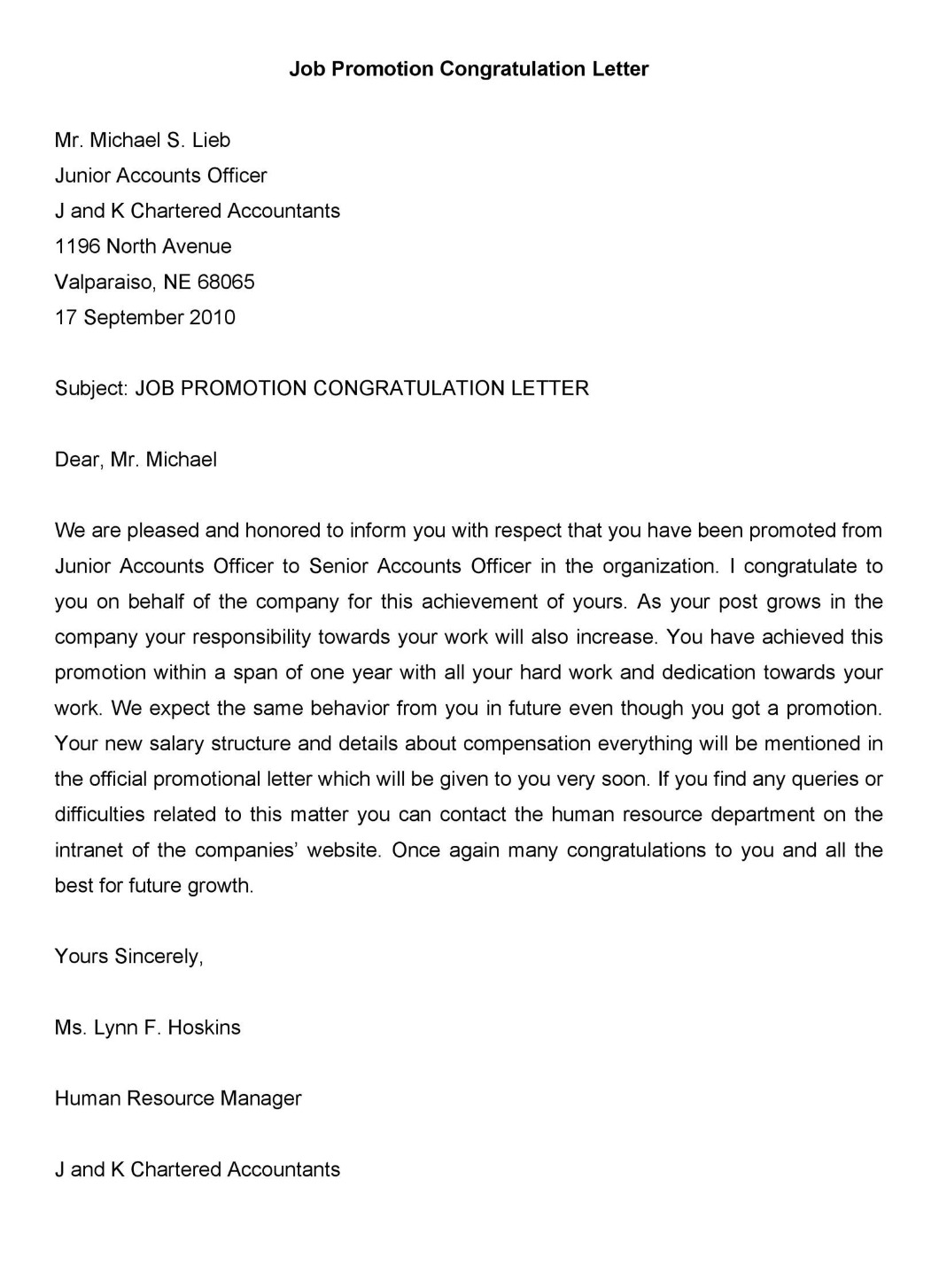
11. Sample Manager Job Promotion Letter Template
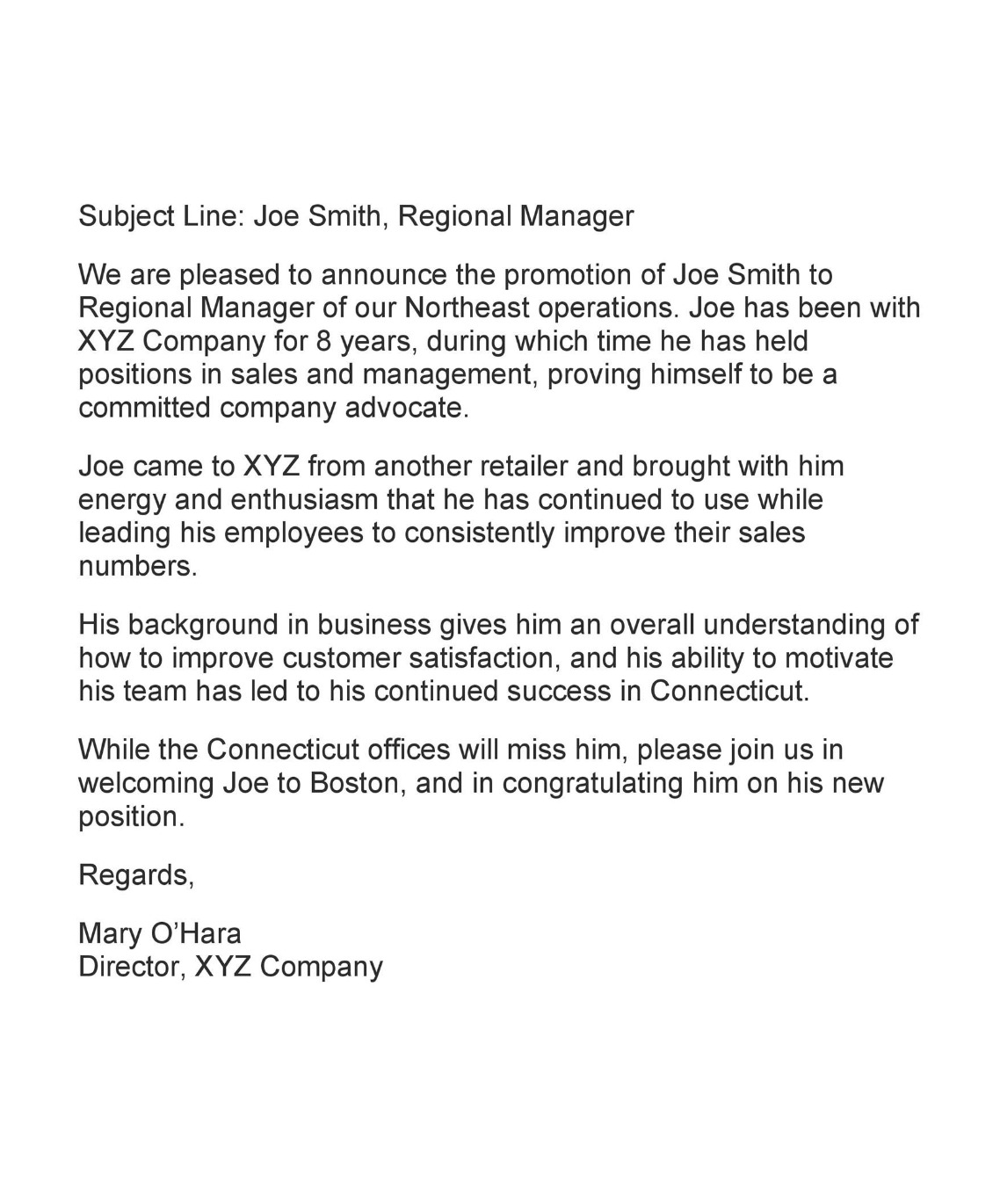
When should an employer send a Job Promotion Letter?
An employer should send a Job Promotion Letter after the decision of promotion is made and before making a public announcement. It’s best to send the letter well before the new role takes effect, allowing time for the employee to prepare for their new responsibilities.
What information should be included in a Job Promotion Letter?
A Job Promotion Letter should include the employee’s new job title, a detailed description of the new role and responsibilities, any changes in salary and benefits, the effective date of the promotion, and any new terms and conditions of employment.
Can a Job Promotion Letter be delivered electronically?
Yes, a Job Promotion Letter can be delivered electronically, especially in organizations where digital communication is standard. However, it’s important to ensure the letter is delivered in a secure and official manner.
Should an employee respond to a Job Promotion Letter?
While not always required, it’s good practice for an employee to formally acknowledge and accept the promotion through a written response. This helps in maintaining clear and formal communication channels.
Related Posts
Letter of Intent Samples & Templates
Letter of Intent for a Job Samples & Templates
Lease Proposal Letter Samples & Templates
Letter of Inquiry Samples & Templates
Character Reference Letter Samples & Templates
Claims Letter Samples & Templates
Response Letter Sample & Templates
Follow Up Letter Samples & Templates
Sample Project Proposal Letter Templates
Donation Letter Samples & Templates
Addressing a Formal Letter Samples & Templates
Grievance Letter Samples & Templates
Sample Sponsor Thank You Letter Templates
Sample Letters of Request
Sample Cover Letter for Teacher
